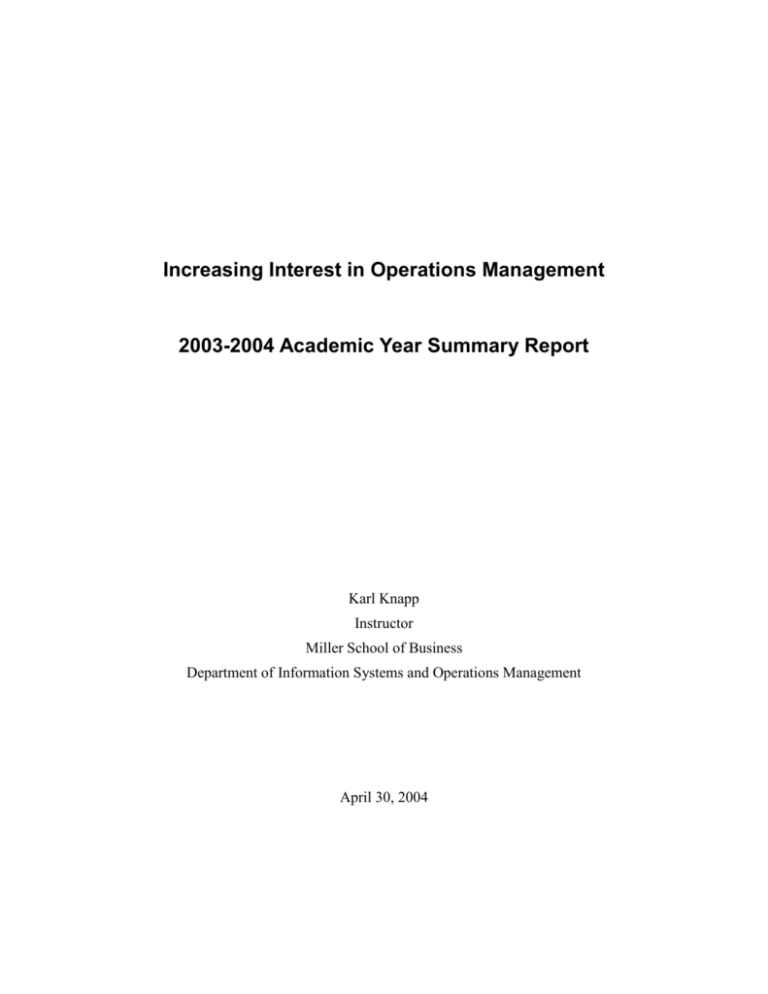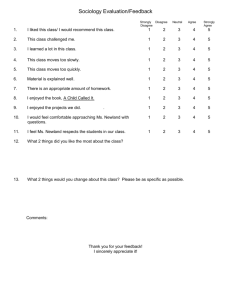Increasing Interest in Operations Management
advertisement

Increasing Interest in Operations Management 2003-2004 Academic Year Summary Report Karl Knapp Instructor Miller School of Business Department of Information Systems and Operations Management April 30, 2004 Background My goal for the 2003-2004 academic year was to increase the level of interest in the operations management major. Increased interest should lead to an increase in the number of operations management majors, which are critically low. The main vehicle used to attain this goal were the six sections of MGT 351 – operations management taught in the Fall 2003 and Spring 2004 semesters. A secondary vehicle was the ‘connections’ program for operations management that I coordinated. Theoretical Framework The main approach to the problem was based on prior research conducted at Ball State on learning styles. This prior study (Knapp, 1993) measured the learning styles of 134 business majors and 34 non-business majors at Ball State. The study is based on Kolb’s experiential learning style theory (1976), using a simplified learning style inventory (LSI) instrument. The results of the study provide support for the hypothesis that business majors favor concrete learning styles. The Accommodator (n=39) and Diverger styles (n=27) (both concrete) are significantly favored over the Converger (n=6) and Assimilator (n=7) styles (both abstract conceptualization). Hypotheses The design of the course is based on the hypothesis that a class taught using a concrete experiential learning tool will increase the level of interest in operations management. Methodology Based on the preference for concrete learning styles of teaching, a course simulation was created enabling students to utilize and experience operations management concepts learned in class. The simulation is based on the familiar metaphor of a chain of pizza restaurants. A very large and complex multi-competitor, single market economic model was constructed using Microsoft Excel. The economic model provides a variety of inputs based on operations management concepts taught throughout the year. For example, the course section on break-even analysis provides the tools for the students to make decisions about building additional stores. Additional operations choices become available following the completion of each chapter (a full discussion of the simulation will be presented in an upcoming article). In each case, groups of students utilize the techniques and concepts learned in the chapter to make informed decisions. Process simulation software (SimQuick) is also used to support the exercise. Instrument A pre- and post-course survey was conducted. This survey measures the level of interest in operations management before and after the operations management course. The survey also measures a variety of perceptions about the simulation exercise. Population 205 students in six sections of MGT 351 (Operations Management) at Ball State University participated in the survey. 260 students were enrolled, yielding a response rate of 78.8%. Of these students, 65.4% are male and 34.6% are female. Most are traditional age (94.1% < 23 years of age) full time (97.1%) students. The majority of the students work either full-time (7.3%) or part-time (60.5%). A breakdown of the students’ academic major area of study: Majoring in: Accounting Marketing Finance Entrepreneurship Human Resources Business Administration BIT Management Risk Management MIS Operations Management Economics IS International Business Sales Business Education Other or Unreported Number 45 37 19 13 12 12 10 8 7 6 3 2 2 2 1 1 25 Percentage 22.0% 18.0% 9.3% 6.3% 5.9% 5.9% 4.9% 3.9% 3.4% 2.9% 1.5% 1.0% 1.0% 1.0% 0.5% 0.5% 12.2% Results Variables Under Study The main variable under study is the interest level in operations management, before and after the operations management course. The results on the aggregate level are as follows: Interested in OM before MGT 351 Interested in OM after MGT 351 Change in percentage Strongly Disagree 6.3% 1.5% (4.9%) Disagree Neutral Agree 27.8% 8.8% (19.0%) 43.9% 34.1% (9.8%) 17.1% 46.3% 29.3% Interested in OM (before MGT 351) Strongly Agree 5% Strongly Agree 4.9% 9.3% 4.4% Interested in OM (after MGT 351) Strongly Disagree 6% Strongly Agree 9% Strongly Disagree 1% Disagree 9% Agree 17% Disagree 28% Neutral 34% Agree 47% Neutral 44% A two-sample test of mean shows that the shift in average interest level (2.86 before to 3.53 after) in operations management was positive and statistically significant at the .05 level (t=7.6, 204 degrees of freedom, p=0.000000000001). On an individual basis there are nine possible values of the shift in interest. They range from a decrease of four levels (from strongly agree to strongly disagree) to an increase of four levels (from strongly disagree to strongly agree). Individual shifts in perception were as follows: Shift in Interest Decreased 4 levels Decreased 3 levels Decreased 2 levels Decreased 1 level Stayed the same Increased 1 level Increased 2 levels Increased 3 levels Increased 4 levels Number 0 0 1 15 80 76 23 8 2 Percent 0.0% 0.0% 0.5% 7.3% 39.0% 37.1% 11.2% 3.9% 1.0% Shift in Interest in Operations Management 45.00% 39.02% 40.00% 37.07% 35.00% 30.00% 25.00% 20.00% 15.00% 11.22% 10.00% 7.32% 3.90% 5.00% 0.00% 0.00% 0.00% 0.49% 0.98% Decreased 4 Decreased 3 Decreased 2 Decreased 1 Stayed the Increased 1 Increased 2 Increased 3 Increased 4 levels levels levels level same level levels levels levels The feedback focused on the semester long pizza simulation reveals the following data: The pizza simulation… improved my understanding of OM concepts improved my understanding of OM techniques piqued my interest in OM was fun helped develop group decision-making skills is recommended for other OM classes needs to be improved Strongly Disagree Neutral Agree Strongly Disagree Agree 1.0% 4.9% 17.1% 64.9% 12.2% 0.5% 5.4% 17.1% 65.4% 11.7% 1.0% 12.2% 35.6% 36.6% 14.6% 0.5% 1.5% 5.9% 48.3% 43.4% 1.0% 6.8% 14.6% 61.0% 16.6% 0.5% 2.0% 10.2% 50.7% 36.6% 2.4% 18.5% 38.5% 36.1% 3.9% Analysis and Discussion On the basis of the significant improvement in the interest level in operations management, I was able to achieve at least some of the results desired at the beginning of the 2003-2004 academic year. The percentage of students responding favorably to an interest in operations management (either agreeing or strongly agreeing) more than doubled from 22% to 56%. Over half the students (53%) increased their interest in operations management by at least one level. The pizza simulation was a major contributor to this success, with over three-quarters of the respondents positive that the simulation improved their understanding of operations management. While I have confirmed that four students have changed majors to operations management as a result of the class, this is a lower number than what was hoped. Because MGT 351 occurs later in the business curriculum, the change is much harder for students to make without delaying graduation. Yet, overall, I consider the efforts of the past year a success. References Knapp, K. (2003). An Empirical Comparison of the Learning Styles of Business and NonBusiness Majors Using Kolb’s Experiential Learning Theory. Proceedings of the Delta Pi Epsilon National Conference, November 21, 2003. Kolb, D. A. (1976). Learning style inventory: technical manual. Boston: McBer.







